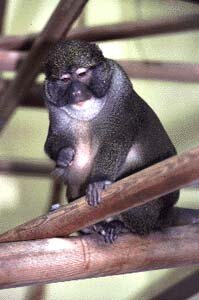
Species Survival Plans (SSPs)
Zoo Matchmaking Becomes a Needed Science
Once, zoos were devoted almost entirely to educational exhibits of wild animals that could be replaced from nature when they eventually died. In the past few decades, as human encroachment has caused the decline of wild populations, the role of zoos has dramatically changed. Today, zoo's not only propagate animals to replace those in their own collections, but as insurance against the unsure fate of animals in the wild.
Survival Takes Special Planning
To help preserve vanishing species, our zoo takes a vital part in Species Survival Plans (SSP) initiated by the American Zoos and Aquariums (AZA).
The goal of SSPs is to preserve the genetic diversity of species and the likelihood of species' future survival, both in captivity and the wild. The programs also help strengthen and coordinate captive breeding plans by individual zoos and, whenever possible, return animals to their wild habitats.
There are currently Species Survival plans for some 77 endangered species.
SSP Species at our Zoo
The Oregon Zoo participates in 21 SSPs:
| Agile Mangabey | Francois langur | red panda * |
| Andean Condor | golden-lion tamarin | ring tailed lemur |
| Asian elephant | Humboldt penguin | Rodrigues bats |
| black rhinoceros | mandrill | Siberian tiger |
| chimpanzee | Maylayan Sun bear | snow leopard * |
| colobus monkeys | mongoose lemur | tree kangaroo |
| DeBrazza monkey | orangutan | white-cheeked gibbon |
We keep meticulous records on each breeding animal's lineage, fertility, sex, longevity, care and medical history. Animals are paired based on the long-term consequences of viability of their gene pool. This also assures no inbreeding will occur in captive populations or any other harmful conditions will be passed on to future animal generations.
* Although we participate in these SSPs, these species are not currently at our zoo.
AZA Studbooks
The Zoo presently holds AZA studbooks for the Asian elephant, cougar, white-faced saki monkey, red-flanked duiker, Impala and straw-colored bat. We work closely with SSP committees that make recommendations for transfers, pairings and breedings of these animals around the country.
Pachyderms Bring Awards
In response to the Zoo's famous Asian elephant breeding program, the AZA has twice presented the Zoo with its most prestigious breeding award. The first was presented in 1962 for the birth of Packy, and again in 1975 for the second generation birth of a male Asian elephant.